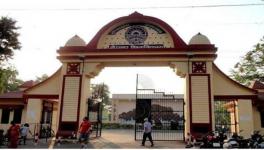Is BRD College Hiding Encephalitis Cases by Creating New Illness Category?

New Delhi: Is the Uttar Pradesh government’s claim that the number of patients suffering from Acute Encephalitis Syndrome (AES) and Japanese Encephalitis (JE) at Baba Raghav Das (BRD) Medical College in Gorakhpur has witnessed a sharp decline in the past two years a reality or an eyewash?
Chief Minister Adityanath in August this year claimed to have reduced the number of AES/JE patients by 35% and deaths caused by the disease by 65%. In Gorakhpur division, officials claimed that AES/JE cases and deaths had decreased by more than 60% in the past two years.
However, doctors in the college allege that the BRD administration is manipulating data, resulting in unrecorded acute encephalitis AES/JE patients. Even the unofficial data accessed by this reporter suggests so. A total of 331 patients — as per the data — have been found JE positive from January to November this year.
This year, acute febrile illness (AFI) patients, have seen an alarming rise at 1,563 cases till November.
Patients suffering from AES/JE exhibit fever as well as signs of fainting, tremors, dementia; whereas, in AFI, patients have a fever of more than 37.5 degree celcius. The fever may last for 2–14 days.
In addition, the patient may complain of headache, dizziness, chills, muscle and joint pain, weakness, vomiting, hypertonia, extensor planter reflex, dystonia, hypokinesia, rigidity, tremors, retention of urine, constipation, confusion, disorientation or coma.
Malaria, scrub typhus, dengue, chikungunya are the main factors in AFI. AFI patients do not have symptoms like tremors, fainting or insanity that distinguish them from AES/JE.
Most of the children admitted under AFI category exhibit symptoms similar to encephalitis, yet are denied the AES number (which is assigned to AES patients to maintain a record), which shows a decrease in the number of encephalitis cases.
There is, therefore, a growing fear that the actual number of encephalitis patients may be hidden by denying them an AES number and registering them under AFI category.
More than 13% of JE cases have been found in AFI patients at BRD Medical College. This number is more than the number of patients found in AES. The finding of JE cases in AFI patients suggests that the actual number of encephalitis patients is being hidden.
The AFI category was introduced in 2018, and since then, patients are being admitted under AFI category AES/JE as well as the newly introduced category of the disease AFI. It is also necessary to mention here that the term AFI was not heard in the BRD Medical College before 2018.
Sources allege that ever since BRD Medical College started categorising patients under AES as well as AFI, there has been a dramatic decrease in encephalitis cases.
Documents accessed from BRD Medical College show that from January this year till date, of 492 cases of AES, 116 were found JE positive. Apart from this, a total of 1,563 AFI cases have been found in the same period in which 215 patients have been found JE positive.
The Regional Medical Research Centre (RMRC) located in BRD Medical College campus tested the samples of 29 AFI patients on October 7 and 9 and found five JE positive cases following a CSF Serum examination. Eleven cases of scrub typhus were also found. Similarly, of the 114 AFI patients who were examined in August 2019, a total of 21 were found JE positive and 56 had scrub typhus. Of these 143 patients, 92 (64%) are children below the age of 15 years.
According to sources in BRD, 215 (13.7%) patients of JE have been found among 1,563 AFI patients from January till November this year. In addition, more than 350 (22.37%) cases of scrub typhus, 50 (3.14%) of dengue and 100 (6.39%) of chikungunya have been found.
Research conducted on 1,564 AFI patients in other five states — Assam, Bihar, Chhattisgarh, Maharashtra, Andhra Pradesh and Tamil Nadu in 2011-12 — showed that there were 17% cases of malaria, 16% of dengue, 10 % of scrub typhus and 6% of chikungunya.
JE positives are found to be very low when AFI patients were tested but finding more than 3% JE positive in AFI patients in BRD Medical College is raising serious questions.
Those suffering from AES/JE are given a compensation of Rs 50,000 from the government if they die. Patients suffering from JE, if saved, are given a compensation of Rs 1 lakh because they develop some disability.
DENIAL BY BRD AND DISTRICT ADMINISTRATION
BRD Medical College Principal, Ganesh Kumar, has rejected any such data and reiterated the chief minister’s claim. “Around 87 patients of AES/JE had been admitted to the hospital in 2019, out of which 19 children died. In 2017, this number was recorded at 2,248, of which 512 had died while in 2018 the total number of footfall of AES/JE patients was at 1,047, with 166 deaths. In 2005, the worst in recent years, the disease had claimed the lives of more than 1,500 children.”.
When asked about AFI, he said: “We are getting cases of scrub typhus, dengue and chikungunya cases this year. And therefore, the new category has been created to separate them from AES/JE patients and there is nothing wrong in this.”
When further asked if JE patients were being found in AFI and AES categories and that there were allegations that JE patients were being denied AES numbers, he clarified, “When such cases came to the fore, the patients are transferred to the AES section and assigned the numbers.”
Shrikant Tripathi, chief medical officer, Gorakhpur, backed the claim of reduction in AES cases. “Earlier restricted to the eastern region, AES/JE has now spread its tentacles to other parts of the state. The deadly disease used to wreak havoc three years back, but now such cases have been brought down in the past two years. The death toll too has witnessed a sharp decline from hundreds to not even tens. Only three deaths have been recorded in the district because of JE virus infection. A total 225 AES patients were admitted in different hospitals in Gorakhpur, of which only 10 died. This number used to be in hundreds earlier,” he told Newsclick.
He said the “development of infrastructure, training of doctors and para medical staff, aggressive public awareness campaigns and cleanliness sensitisation programmes and ‘Dastak Abhiyan’ have contributed to the large-scale eradication of the deadly diseases. Twelve government departments (such as health, municipal corporation, Panchayti Raj, ICDS, education department, etc) work in coordination to spread awareness in rural and urban areas. Making the district open defecation free has also played a key role in controlling the AES. Three PICUs (Pediatric Intensive Care Unit) set up Gagha, Pipirauli and Chauri Chaura are also helping a lot in providing necessary treatment to patients in time. If AES patients get proper and timely treatment, their chances of recovery go high”.
But sources in the hospital termed this as an eyewash. A doctor in the paediatric department said: “JE is generally accomplished by testing of CSF to detect virus-specific IgM antibodies. Categorising under the AFI category, instead of AES, the patients are denied proper diagnostic examination and medicine protocol. Several patients here have died here because of the JE, but records suggest they were suffering from AFI,” he said on condition of anonymity.
The doctor admitted that the government had launched a campaign to bring the AES cases down, but questioned that if vaccinations were taking place, how come such a large number of infected patients were coming to the medical college. “Around 95% of AES patients admitted at BRD are already vaccinated. How is this possible? Either the cold chain is not being maintained or the children are not being vaccinated twice within the prescribed of two months,” he added.
As per government of India guidelines, two doses of JE vaccine have been approved to be included in the Universal Immunisation Programme (UIP) to be given one along with measles at the age of nine months and the second with DPT booster (a combination of vaccines against diptheria, tetanus toxoids and pertussis) at the age of 16-24 months.
Meanwhile, people in the know demanded an independent probe into the matter, adding that “it’s a violation of right to health of a large section of the population”. “The government and the hospital administration must institute an independent inquiry to clear the air,” they added.
The patients being admitted at BRD, which is a referral hospital, do not necessarily belong to Gorakhpur. There are patients from Deoria, Kushinagar, Maharajganj, Sant Kabir Nagar, Siddharth Nagar in eastern Uttar Pradesh apart from few from Bihar.
Get the latest reports & analysis with people's perspective on Protests, movements & deep analytical videos, discussions of the current affairs in your Telegram app. Subscribe to NewsClick's Telegram channel & get Real-Time updates on stories, as they get published on our website.
























